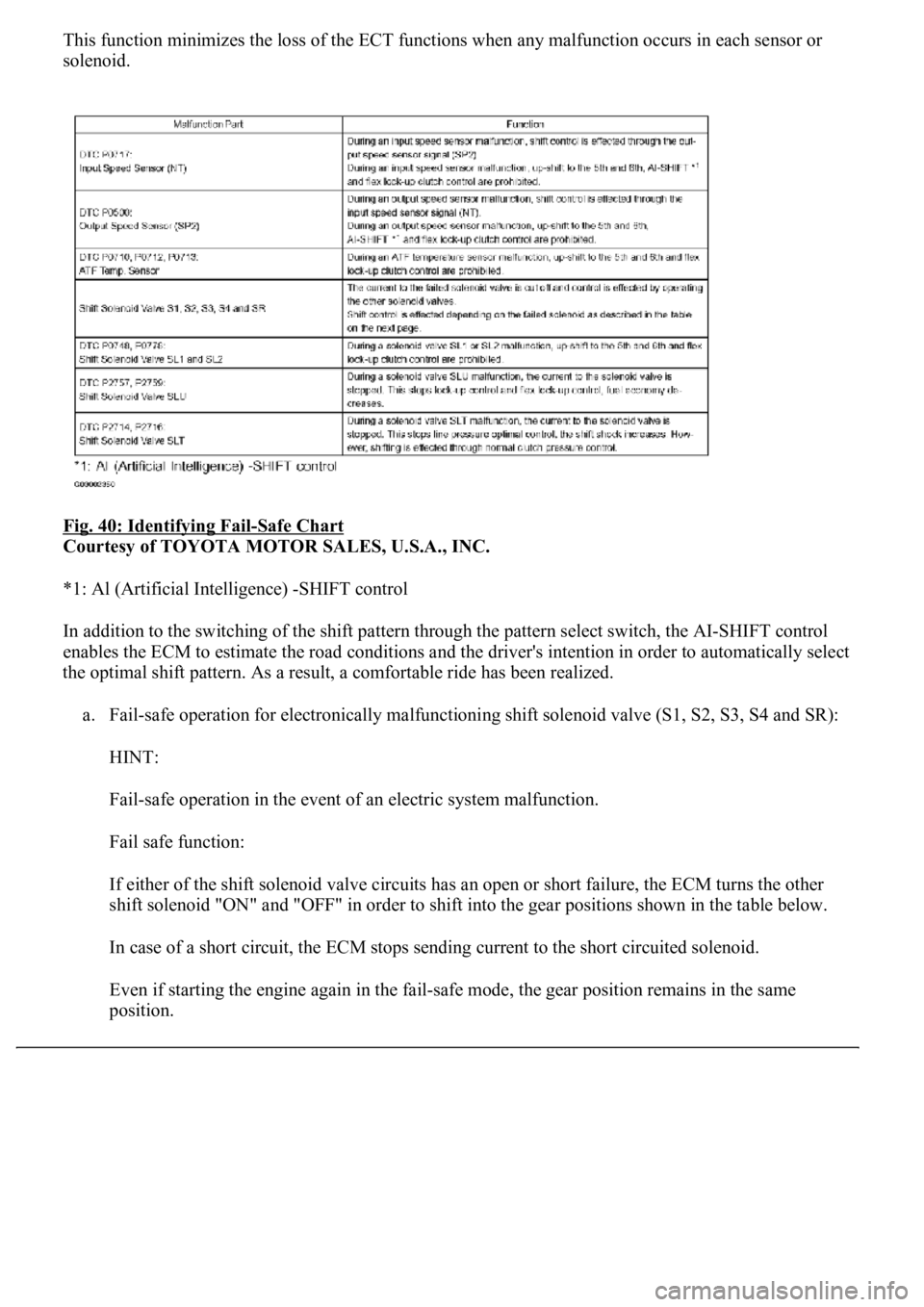Page 2706 of 4500
Fig. 28: Identifying Waveform 3
Courtesy of TOYOTA MOTOR SALES, U.S.A., INC.
Reference:
WAVEFORM 3 REFERENCE TABLE
Waveform 4
TerminalSL2+ - SL2-
Tool setting5V/DIV, 1ms/DIV
Vehicle conditionEngine idle speed
Page 2707 of 4500
Fig. 29: Identifying Waveform 4
Courtesy of TOYOTA MOTOR SALES, U.S.A., INC.
Reference:
WAVEFORM 4 REFERENCE TABLE
Waveform 5
TerminalSL1+ - SL1-
Tool setting5V/DIV, 1ms/DIV
Vehicle condition5th or 6th gear
Page 2708 of 4500
Fig. 30: Identifying Waveform 5
Courtesy of TOYOTA MOTOR SALES, U.S.A., INC.
Reference:
WAVEFORM 5 REFERENCE TABLE
Waveform 6
TerminalNT+ - NT-
Tool setting1V/DIV, 2ms/DIV
Vehicle conditionEngine idle speed (P or N position)
Page 2709 of 4500
Fig. 31: Identifying Waveform 6
Courtesy of TOYOTA MOTOR SALES, U.S.A., INC.
Reference:
WAVEFORM 6 REFERENCE TABLE
DIAGNOSIS SYSTEM
DESCRIPTION
When troubleshooting On-Board Diagnostic (OBD II) vehicles, the vehicle must be connected to the OBD II
scan tool (complying with SAE J1987). Various data output from the vehicle's ECM can then be read.
OBD II regulations require that the vehicle's on-board computer illuminates the Malfunction Indicator Lamp
(MIL) on the instrument panel when the computer detects a malfunction in:
1. The emission control s
ystem/components
TerminalSP2+ - SP2-
Tool setting2V/DIV, 20ms/DIV
Vehicle conditionVehicle speed 20 km/h (12 mph)
Page 2712 of 4500
Fig. 34: Identifying DLC3 Terminals
Courtesy of TOYOTA MOTOR SALES, U.S.A., INC.
FREEZE FRAME DATA
Freeze frame data records the engine conditions (fuel system, calculated load, engine coolant temperature, fuel
trim, engine speed, vehicle speed, etc.) when a malfunction is detected. When troubleshooting, freeze frame
data can help determine if the vehicle was running or stopped, if the engine was warmed up or not, if the air/fuel
ratio was Lean or Rich, and other data from the time the malfunction occurred.
The hand-held tester records freeze frame data in five different instances: 1) 3 times before the DTC is set, 2)
once when the DTC is set, and 3) once after the DTC is set. These data can be used to simulate the vehicle's
condition around the time when the malfunction occurred. The data may help find the cause of the malfunction,
or
judge if the DTC is being caused by a temporary malfunction or not.
Page 2714 of 4500
Fig. 36: Identifying DLC3 Terminals
Courtesy of TOYOTA MOTOR SALES, U.S.A., INC.
DLC3 REFERENCE TABLE
SymbolTerminal No.Name
Reference
terminal
ResultCondition
SIL7Bus "+" line5 - Signal groundPulse generationDuring
transmission
CG4Chassis groundBody groundBelow 1 ohmsAlways
SG5Signal groundBody groundBelow 1 ohmsAlways
BAT16Battery positiveBody ground11 to 14 VAlways
CANH6HIGH-level
CAN bus lineCANL54 to 69 ohmsIG switch OFF
CANH6HIGH-level
CAN bus lineBattery positive1 Mohms or
higherIG switch OFF
CANH6HIGH-level
CAN bus lineCG1 kohms or
higherIG switch OFF
CANL14LOW-level
CAN bus lineBattery positive1 Mohms or
higherIG switch OFF
CANL14LOW-level CG1 kohms or IG switch OFF
Page 2718 of 4500
f. Change the ECM to check mode. Make sure the MIL flashes as shown in the illustration.
g. Start the engine. The MIL should turn off after the engine starts.
h. Perform "MONITOR DRIVE PATTERN" for the ECT test (see MONITOR DRIVE PATTERN
).
(Or, simulate the conditions of the malfunction described by the customer).
i. After simulating the malfunction conditions, use the hand-held tester diagnosis selector to check the DTC
and freeze frame data.
Fig. 39: Identifying MIL Blinking Pattern
Courtesy of TOYOTA MOTOR SALES, U.S.A., INC.
FAIL-SAFE CHART
1.FAIL-SAFE
Page 2719 of 4500

This function minimizes the loss of the ECT functions when any malfunction occurs in each sensor or
solenoid.
Fig. 40: Identifying Fail
-Safe Chart
Courtesy of TOYOTA MOTOR SALES, U.S.A., INC.
*1: Al (Artificial Intelligence) -SHIFT control
In addition to the switching of the shift pattern through the pattern select switch, the AI-SHIFT control
enables the ECM to estimate the road conditions and the driver's intention in order to automatically select
the optimal shift pattern. As a result, a comfortable ride has been realized.
a. Fail-safe operation for electronically malfunctioning shift solenoid valve (S1, S2, S3, S4 and SR):
HINT:
Fail-safe operation in the event of an electric system malfunction.
Fail safe function:
If either of the shift solenoid valve circuits has an open or short failure, the ECM turns the other
shift solenoid "ON" and "OFF" in order to shift into the gear positions shown in the table below.
In case of a short circuit, the ECM stops sending current to the short circuited solenoid.
Even if starting the engine again in the fail-safe mode, the gear position remains in the same
position.